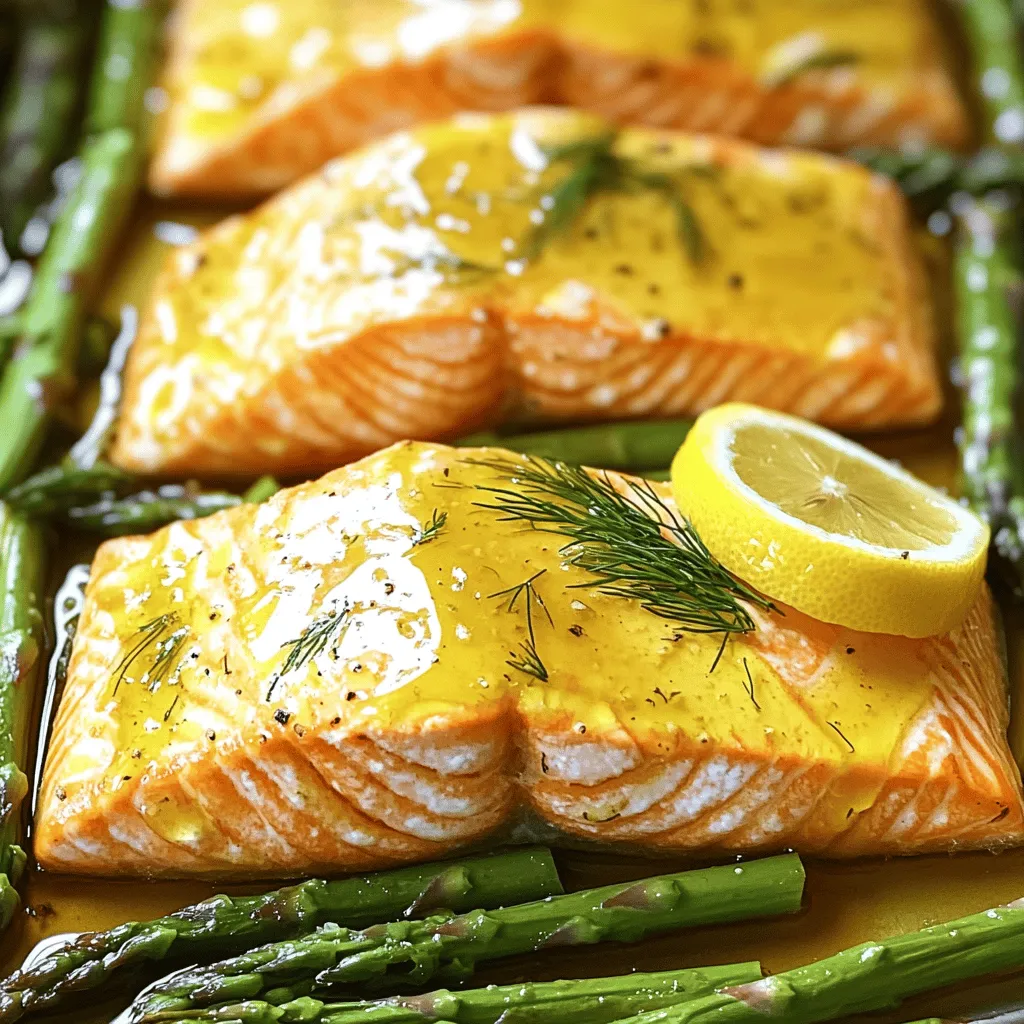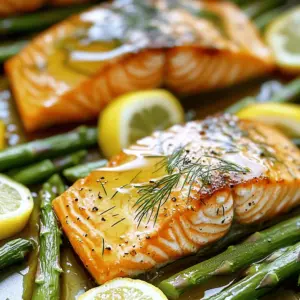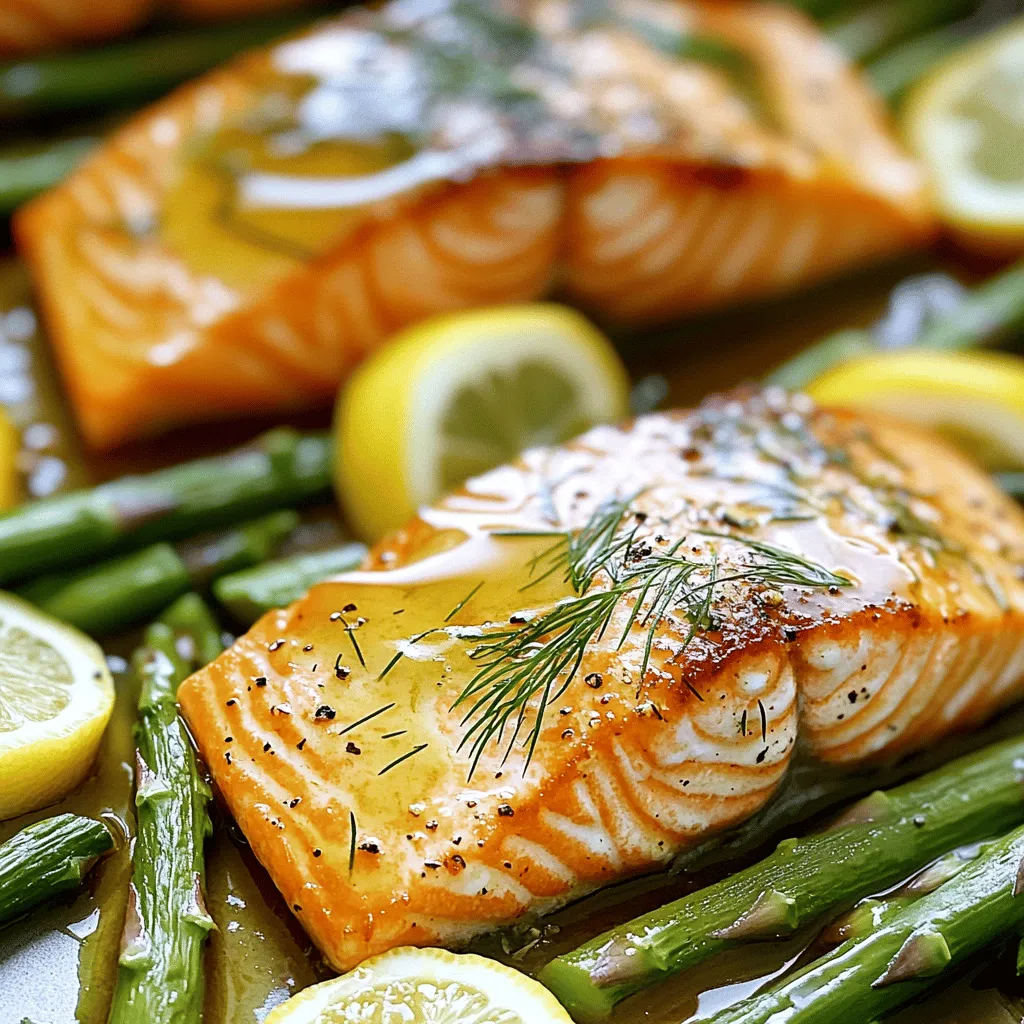Are you looking for an easy main dish that’s full of flavor? Look no further than Lemon Dijon Salmon with Asparagus! This healthy recipe is packed with fresh ingredients and simple steps. You’ll only need a few minutes to whip up the tangy Dijon glaze and bake your salmon to perfection. Let’s dive into this delightful dish that will impress your family and friends!
Ingredients
Main Ingredients List
– 4 salmon fillets
– 1 bunch asparagus, trimmed
Flavorful Seasoning Ingredients
– 3 tablespoons Dijon mustard
– 2 tablespoons honey
– 2 tablespoons olive oil (plus extra for drizzling)
– 2 cloves garlic, finely minced
– Zest and juice of 1 large lemon
– Sea salt and freshly cracked pepper to taste
Garnish Suggestions
– Fresh dill or parsley sprigs for garnish
For this dish, I like to use fresh salmon fillets. Look for bright, firm fish, as it tastes better. The asparagus should be vibrant green, and the tips should be tightly closed. This ensures freshness and flavor.
The Dijon mustard adds a nice tang. Honey balances it with sweetness. Olive oil keeps everything moist. Garlic brings in a savory kick. Lemon zest and juice add brightness. Finally, the sea salt and pepper enhance all flavors.
Using fresh herbs like dill or parsley adds a pop of color. It also brings in a fresh taste. You can use these herbs as a final touch. They make the dish look pretty and inviting.
Keep these ingredients ready, and you will create a tasty Lemon Dijon Salmon with Asparagus.
Step-by-Step Instructions
Preheat the Oven
Start by setting your oven to 400°F (200°C). This heat cooks the salmon and asparagus evenly and quickly.
Prepare the Dijon Honey Glaze
In a medium bowl, mix together:
– 3 tablespoons Dijon mustard
– 2 tablespoons honey
– 2 tablespoons olive oil
– 2 cloves garlic, minced
– Zest and juice of 1 lemon
Whisk these ingredients until smooth. This glaze adds a burst of flavor.
Seasoning and Coating the Salmon
Take your salmon fillets and season them with:
– Sea salt
– Freshly cracked pepper
Make sure to season both sides. Place the fillets in a greased baking dish, skin side down if needed. Next, take the glaze and spread it evenly over the top of each fillet.
Preparing the Asparagus
Trim the asparagus and nestle it around the salmon in the baking dish. Drizzle some olive oil over the asparagus and sprinkle with sea salt and pepper. This helps the asparagus stay fresh and tasty.
Baking Instructions
Put the baking dish in your preheated oven. Bake for 12-15 minutes. You know it’s done when the salmon flakes easily with a fork, and the asparagus is tender but bright green.
Final Touches
After baking, let the dish rest for about 3 minutes. This resting time makes the texture better. Garnish with fresh dill or parsley. This adds color and a fresh taste right before serving.
Tips & Tricks
Selecting Fresh Ingredients
How to choose quality salmon
When picking salmon, look for bright, shiny skin. The flesh should feel firm and spring back when pressed. Avoid fish with any brown spots or a strong fishy smell. If possible, buy wild-caught salmon for better flavor and health benefits.
Identifying fresh asparagus
Fresh asparagus stalks should be bright green and firm. Check the tips; they should be closed and compact, not slimy or wilted. If the ends are dry, they may not be fresh. Look for thick spears for a juicy bite.
Modifying Cooking Times
Adjustments for thicker fillets
If your salmon fillets are thicker than an inch, you may need to add a few extra minutes to your baking time. Start checking for doneness at 15 minutes. The salmon should flake easily with a fork.
Cooking recommendations for perfect texture
For the best texture, avoid overcooking. Salmon is perfect when it has a slight sheen and is a bit pink in the center. Use a meat thermometer; aim for 125°F (52°C) for medium-rare.
Presentation Tips
Plating styles for serving
To serve, arrange the salmon and asparagus on a large platter. This makes it easy for everyone to help themselves. Place the salmon in the center and surround it with asparagus for a colorful display.
Adding extra lemon for brightness
Squeeze fresh lemon juice over the dish just before serving. This adds a burst of flavor and makes the dish look even more inviting. Garnish with sprigs of dill or parsley for a touch of elegance.

Variations
Lemon Dijon Salmon with Different Vegetables
You can switch up the veggies to keep things fresh. Instead of asparagus, try broccoli or green beans. Both pair well with the salmon’s flavor. Carrots or zucchini can also add a nice touch. Just remember to adjust the cooking time if you choose thicker veggies.
Flavor Enhancements
Want to spice it up? You can add herbs like thyme or basil to the glaze. A pinch of red pepper flakes adds heat and depth. You can also mix in some smoked paprika for a smoky twist. Each of these options gives the dish a unique flair.
Cooking Methods
Grilling gives salmon a smoky flavor. It also creates beautiful grill marks. Just preheat the grill and cook for about six minutes per side. Baking is easier and keeps the salmon moist. You can also broil it for a crispy top. Broiling takes less time, so watch closely to avoid burning. Each method gives a different taste and texture. Try them all to find your favorite!
Storage Info
Refrigeration Guidelines
To store leftovers properly, let the salmon cool first. Place it in an airtight container. Keep the asparagus with the salmon or in a separate container. This will help keep them fresh. Store in the fridge for up to three days. When you’re ready to enjoy leftovers, check for any off smells before eating.
Reheating Suggestions
The best way to reheat salmon is in the oven. Preheat your oven to 350°F (175°C). Place the salmon on a baking tray. Add a splash of water or broth to help keep it moist. Cover it with foil to prevent drying. Heat for about 10-15 minutes. The salmon should be warm but not overcooked. For the asparagus, you can reheat them in a pan with a little olive oil.
Freezing Tips
Yes, you can freeze Lemon Dijon Salmon! Make sure it is completely cool before freezing. Wrap each piece tightly in plastic wrap, then place it in a freezer bag. You can freeze it for up to three months. To defrost safely, move the salmon to the fridge overnight. This keeps it at a safe temperature. You can also use the defrost setting on your microwave, but be careful not to cook it.
FAQs
How long should I bake salmon?
You should bake salmon for about 12 to 15 minutes. Check for doneness by using a fork to see if it flakes easily. If it does, it’s ready! The salmon should be opaque and moist inside. Baking time can change based on thickness. Thicker fillets may need a few extra minutes. Always aim for that perfect flaky texture.
Can I use other types of fish?
Yes, you can use other types of fish if you like. Cod, trout, or halibut work well. These fish have similar cooking times. Adjust the baking time if your fish is thicker or thinner. You can keep the same glaze for flavor. Experimenting with different fish can bring new tastes to your table.
What sides pair well with Lemon Dijon Salmon?
Many sides go great with Lemon Dijon Salmon. Here are some popular options:
– Roasted potatoes
– Quinoa salad
– Garlic mashed potatoes
– Steamed broccoli
– Mixed greens salad
These sides complement the flavors of the salmon. You can also try a light pasta or grain dish. Feel free to mix and match based on your mood!
Is it healthy?
Yes, this dish is quite healthy! Salmon is rich in omega-3 fatty acids. These fats are good for your heart and brain. Asparagus adds fiber and vitamins. The glaze uses honey and Dijon, which adds flavor without too many calories. Overall, this meal is a tasty way to eat well!
This blog post covered all you need to create tasty Lemon Dijon Salmon with asparagus. You learned about the main ingredients, how to make a flavorful glaze, and tips for perfect cooking. Remember to choose fresh ingredients and consider different cooking methods for variety. Enjoy garnishing your dish and serving it with your favorite sides. With these steps, you can make a healthy, delicious meal any time. Now, get cooking and enjoy every bite!

